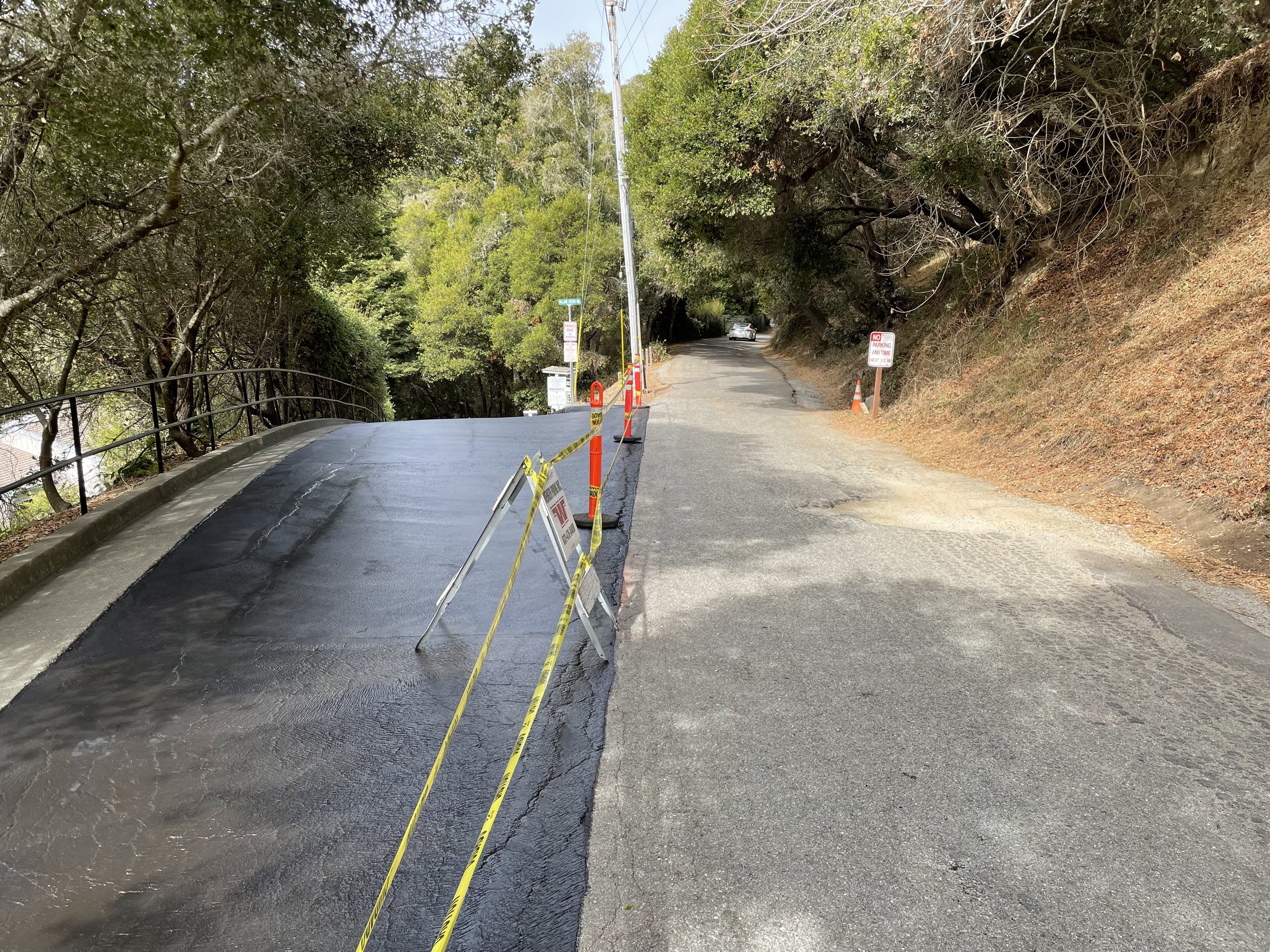What Budget?
Less Money Mo Potholes

Santa Cruz County is broke and our streets are broken.
Our roads are the primary pathways connecting our community. Whether you walk them, bike then, drive them, or ride them, you depend on our roadways to get just about anywhere.
In some areas, road condition is fine and Complete Streets have already been developed. Unfortunately, much of the 600 miles of roads in unincorporated Santa Cruz County are in poor condition.
Is Aptos even a town?
Reports of our Township are greatly exaggerated.
According to our iconic sign, Aptos has been a town since 1893! This date is historically accurate, but the designation can be misleading.
The community of Aptos is split between Townships 11S01E & 11S01W.
Where’s Town Hall? It doesn’t exist.
Who’s our mayor? We don’t have one.
See, the Township from 1893 is a Survey Township not a Civil Township. Aptos has remained unincorporated, so the entirety of our local representation falls on the shoulders of a single elected official: 2nd District County Supervisor.
The community of Aptos is proud & protective of its “small town” vibe. This is part of what makes Aptos so special! Some residents may resist the prospect of incorporation for fear of turning into a “city.” But incorporated communities can choose to designate as City or Town. For example, nearby Los Gatos & Saratoga are both incorporated communities with approx. population of 30,000. However, one is a Town and the other is a City.
In comparison, all of Santa Cruz County’s incorporated areas have been designated as Cities: Santa Cruz (pop. ~63k), Watsonville (pop. ~53k), Scotts Valley (pop. ~12k), and Capitola (pop. ~10k).
Although Aptos is unincorporated, its neighborhoods have been defined by Census Designated Place (CDP). The “Town of Aptos” would sensibly incorporate the Aptos Village area along with Seacliff & Rio Del Mar, for a total population of approx. 19,000.
Of course, population is only part of the picture. Population density helps paint the “vibe” of the community.
Based on the data above, the “Town of Aptos” would have higher population than Scotts Valley and Capitola, but its population density would be the lowest in the county. This helps depict why Aptos is better described as a “town” than a “city.”
Unlike neighboring counties of Santa Clara & Monterey, about half of Santa Cruz County’s population live in unincorporated areas. This means that communities like Aptos have no local revenue or representation!
All we have to support our local interests are one County Supervisor and the shoestring budget of Santa Cruz County.
Santa Clara County collects annual revenue of $8.7B, Monterey County collects $1.7B, while Santa Cruz County’s revenue is only $0.8B. Of course, these figures aren’t very helpful without accounting for relative populations, which total approx. 1.9M, 434k, & 272k respectively. Breaking this down to revenue per capita helps paint the picture.
If Santa Cruz County had the same annual revenue per capita as Monterey County, we’d have an extra $219M per year in our coffers!
For comparison, this is about 10x higher than Measure D annual revenue of ~$22M.
Based on assessed road conditions, here in District 2 alone we currently need ~$82M to repair or maintain our unincorporated roads. And since it is much cheaper to maintain a road in good condition than to repair and rebuild a road in poor condition, this cost is likely to grow unless we quickly tackle this deferred maintenance.
Where does money come from?
It certainly doesn’t grow on trees!
But we can make a pie of it! Over half our county’s revenue comes from State & Federal aid. 20% comes from Taxes and 12% from Charges for Services.
How much of this pie goes to Dept of Public Works? About $87M, with ~$2.8M (3%) from Measure D and ~$76M (87%) from State & Federal aid.
Unincorporated District 2 alone needs ~$82M
just to repair or maintain existing roads! Public Works estimates ~$267M is currently needed countywide for local roads.
Since Public Works only brings in ~$87M per year, it would take about 3 years to fund today’s need for maintenance & repairs. Since seasonal damage & degradation seem likely to outpace mitigation efforts, we seem to be moving one step forward two steps back…
In order to flip this thing back around and truly fix dangerous roadway conditions, we’re going to need fundamental change.

Without fundamental change, we’re only keeping our head above water

What’s the root of the problem here?
Quite frankly, Santa Cruz County doesn’t have enough money to service the needs of our roadways.
Unfortunately, the new Infrastructure Investment and Jobs Act (IIJA) isn’t likely to solve our problems here.
Measure D & SB1 remain primary funding sources for new transportation projects in Santa Cruz County, but this pie isn’t large enough to feed everyone’s appetite.
If we want matters to be addressed here, we may need to take matters into our own hands…
…or at least lend more of a helping hand!
Is Santa Cruz County really broke?
SCC Government is starved of funds, and many residents are desperately struggling with housing affordability.
Meanwhile, Santa Cruz County remains a great place to place great wealth. But is a fair share being shared?
Santa Cruz County median household income is about 16% higher than in Monterey County, and typical home value is 44% higher. Therefore, you might expect Santa Cruz County to bring in more tax revenue per capita than Monterey County - and you’d be right!
Compared to Monterey County, Santa Cruz County brings in more revenue per capita in Taxes and State & Federal Aid.
However, Monterey County collects significantly more revenue per capita via “Charges for Service", “Other Financing Sources,” and “Use of Money & Real Property.”
The net effect is that Santa Cruz County annual revenue is $805 less per capita. Multiplied by our population of ~272k, this represents an
annual $219M opportunity cost!
Of Money and Men
Monterey County annually receives $590 per capita in taxes, while Santa Cruz County brings in $610, or 3% more.
But with 16% higher median household income & 44% higher median home value - shouldn’t our tax revenue per capita be even higher?
Imagine if Santa Cruz County had 17% higher per capita tax revenue than Monterey - more in line with our median income & home value. Then we’d receive an extra $22M in annual revenue (same as Measure D)!
What about property taxes?
Median home value is substantially higher in Santa Cruz County than Monterey County, but this isn’t proportionally reflected in our county revenue stream.
Why not? Well, it’s complicated, but not too complicated for taxpayers to grasp.
Prop 13?! Well, kind of. I mean, that’s part of the story. But again, it’s complicated. Let’s break this down.
Thanks to Prop 13, median assessed home value is substantially lower than market value. This helps long-time residents stay in their long-time homes, which is a good thing!
Compared to Monterey County, Santa Cruz County median home market value is 44% higher but median home assessed value is only 15% higher. Since property tax is based on assessed value, we might expect Santa Cruz County to collect about 15% more property tax revenue per capita than Monterey County.
Instead, Santa Cruz County receives ~26% less per capita in property tax revenue than Monterey County!
In fact, total property tax revenue in Monterey County is double that of Santa Cruz County ($1.7M vs $0.8M)!
The net effect? Monterey County’s General Fund receives $236M annually from property tax while we only receive $109M. That’s a $127M/yr difference!
So compared to Monterey County, Santa Cruz County has 44% higher median home value & 15% higher median assessed value…
…yet we pay half the property tax and our county government receives 26% lower property tax revenue per capita?!
Well, oddly enough,
Text














